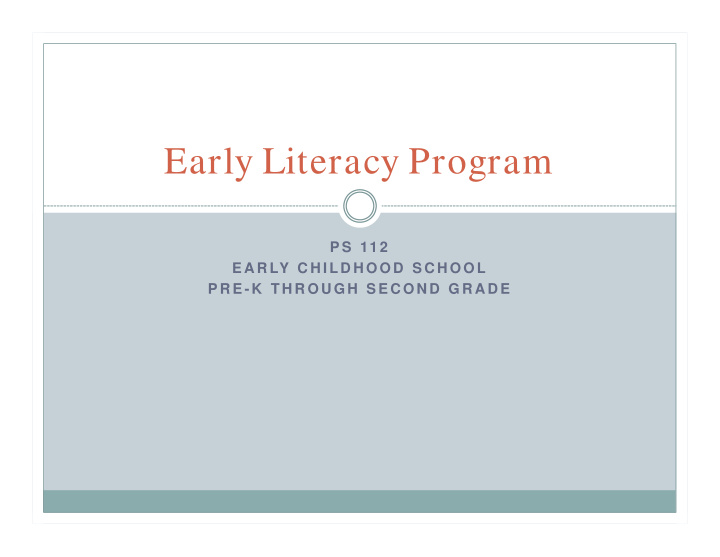



Early Literacy Program P S 11 2 E A R LY C H I L D H O O D S C H O O L P R E - K T H R O U G H S E C O N D G R A D E
Demographics • Asian 3.0% • Black 24.9% • Hispanic 64.3% • White 5.8% • Other 1.9% • 100% Reduced Price Lunch • English Language Learners 17.7% • Special Education 31.9%
Classes At PS 112 9 ASD NEST Integrated Co-Teaching Classes ( 2 of these classes are Dual Language Classes) 1 ASD Intensive Kindergarten 6:1:1 Class 5 Integrated Co-Teaching Classes (5 of which are Dual Language Classes) 1 Self Contained 12:1:1 Classes 4 general Education Classes 2 Pre-k Classes
Literacy Program At PS 112 What Does It Look Like? Our Reading Program is aligned to the Common Core Standards PS 112 is a Teachers College Reading Writing Project School. We im plem ent a year long rigorous curriculum w ith units of study in reading and w riting. School W id e Focus Stud ent to stud ent d iscussions a nd q uestioning. Tea ching the a rt of conv ersa tion w ith stud ents. Com ponents of PS 112’s Balanced Literacy Program Phonics Instruction- We use Fundations which is a research based • program to develop decoding skills and the instructional analysis of words. (letter/ sound, phonemic awareness, knowledge identifying word families, chunking; does the word make sense?, Do letters match sounds?
Components of Our Balanced Literacy Program Read Alouds -To improve students listening skills, reading comprehension and build vocabulary Shared Reading- The teacher models the three cueing systems of reading: phonics, grammar, and meaning by making his/ her thinking transparent as he/ she asks , Does this make sense ? Does it sound right? Does it look right?
Guided Reading -The teacher works with a small group of students (no more than 3 or 4 students on the same level)
Independent Reading- Students read “Just Right Books.” The purpose is for students to apply reading strategies, develop fluency and to challenge the reader to work on his/ her own Vocabulary Developm ent through Inquiry Based Learning (Vocabulary is not taught in isolation) Speaking and Listening- Student To Student Discussions and Questioning (Students making their thinking visible) Com prehension- Constructing meaning; literal, Inferential and evaluative
Writing Interactive Writing Units of Study ( Examples: All About Books; How To Books; Historical Fiction; Poetry; Opinion; Small Moments) Reading/ Writing Connection Students are writing across the curriculum
Intervention/ RTI Support for Struggling Readers PS 112 has three Reading Recovery teachers “At risk” support with a Special Education teacher Extended Day Program-Fountas and Pinnell’s Leveled Literacy Intervention System Saturday Academy Small group differentiated instruction to meet the diverse needs of all students in classroom.
Special Education Students and English Language Learners Instruction is scaffolded and broken down to ensure that all students have access to the grade level curriculum. Emphasis is on a multi-sensory approach Emphasis on oral language development * PS 112 has five speech providers
Inquiry Based Learning
The Inquiry Process In the Classroom Topic discussions of student’s prior knowledge about a topic Link to student’s wonderings and questions Search for Answers Investigations Observations Reseach
Culmination Project Record findings Make a presentation
Inquiry in Social studies
Social Emotional Learning We are committed to supporting the growth and development of children’s emotional well being by: Creating safe nurturing classroom cultures Teach skills of self awareness and self regulation Provide opportunities for students to practice these skills as a class and as individuals
Concentration and attention training-meditation Yoga Movement Breaks such as : wall push ups; jumping jacks; crab walks; balancing egg Use of literature school wide community books to build community and vocabulary around feelings and strategies for dealing with their feelings A “Peace Corner” (Time in place) in every classroom where students who need a break can go and engage in activities for self regulation.
Recommend
More recommend